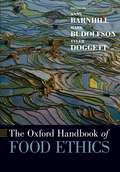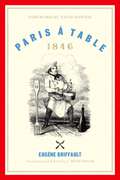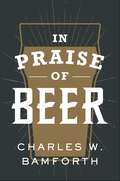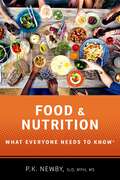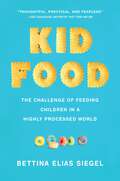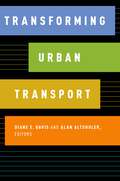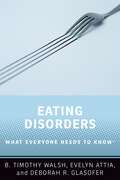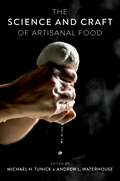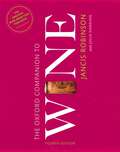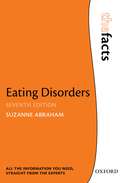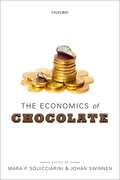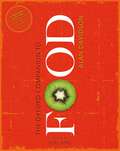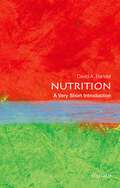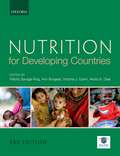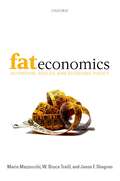- Table View
- List View
The Oxford Handbook of Food Ethics (Oxford Handbooks)
by Anne Barnhill, Mark Budolfson and Tyler DoggettAcademic food ethics incorporates work from philosophy but also anthropology, economics, the environmental sciences and other natural sciences, geography, law, and sociology. Scholars from these fields have been producing work for decades on the food system, and on ethical, social, and policy issues connected to the food system. Yet in the last several years, there has been a notable increase in philosophical work on these issues-work that draws on multiple literatures within practical ethics, normative ethics and political philosophy. This handbook provides a sample of that philosophical work across multiple areas of food ethics: conventional agriculture and alternatives to it; animals; consumption; food justice; food politics; food workers; and, food and identity.
Paris à Table: 1846
by Eugène BriffaultDescribed by Le Monde as "the richest view of Balzac's time seen from the table," Paris à Table: 1846 is an essential text in the history of gastronomy, along with Brillat-Savarin's The Physiology of Taste and Dumas's Dictionary of Cuisine. Its author, Eugène Briffault, was well-known in his day as a theater critic and chronicler of contemporary Paris, but also as a bon-vivant, celebrated for his ability to quaff a bell jar full of champagne in a single draft and well-qualified to write authoritatively about the culinary culture of Paris. Focusing on the manners and customs of the dining scene, Briffault takes readers from the opulence of a meal at the Rothschilds' through every social stratum down to the student on the Left Bank and the laborer eating on the streets. He surveys the restaurants of the previous generation and his own--from the most elegant to the lowest dive--along with the eating habits of the bourgeoisie, the importance and variety of banquets, the institutional meal, and even the plight of "people who do not dine," artists and intellectuals who fell on hungry times. He records the specialties, the décor, the patrons, and the restaurateurs and their waiters. A fine storyteller, Briffault collected culinary anecdotes, from the tantrums of a king deprived of his spinach to the tragedy of "the friendliest pig that was ever seen." The volume includes the humorous drawings of the caricaturist Bertall that cleverly reinforce the witty and ironic tone of the text. Along with J. Weintraub's introduction--which provides the first modern biography of the author and analyzes the place of Paris à Table in the literary culture of the time--the text is copiously annotated, acquainting readers with the events and characters that enliven the narrative. Paris à Table provides a delightful and delectable entryway to Briffault's Paris, the city Walter Benjamin characterized as "the capital of the nineteenth century."
Paris à Table: 1846
by Eugène BriffaultDescribed by Le Monde as "the richest view of Balzac's time seen from the table," Paris à Table: 1846 is an essential text in the history of gastronomy, along with Brillat-Savarin's The Physiology of Taste and Dumas's Dictionary of Cuisine. Its author, Eugène Briffault, was well-known in his day as a theater critic and chronicler of contemporary Paris, but also as a bon-vivant, celebrated for his ability to quaff a bell jar full of champagne in a single draft and well-qualified to write authoritatively about the culinary culture of Paris. Focusing on the manners and customs of the dining scene, Briffault takes readers from the opulence of a meal at the Rothschilds' through every social stratum down to the student on the Left Bank and the laborer eating on the streets. He surveys the restaurants of the previous generation and his own--from the most elegant to the lowest dive--along with the eating habits of the bourgeoisie, the importance and variety of banquets, the institutional meal, and even the plight of "people who do not dine," artists and intellectuals who fell on hungry times. He records the specialties, the décor, the patrons, and the restaurateurs and their waiters. A fine storyteller, Briffault collected culinary anecdotes, from the tantrums of a king deprived of his spinach to the tragedy of "the friendliest pig that was ever seen." The volume includes the humorous drawings of the caricaturist Bertall that cleverly reinforce the witty and ironic tone of the text. Along with J. Weintraub's introduction--which provides the first modern biography of the author and analyzes the place of Paris à Table in the literary culture of the time--the text is copiously annotated, acquainting readers with the events and characters that enliven the narrative. Paris à Table provides a delightful and delectable entryway to Briffault's Paris, the city Walter Benjamin characterized as "the capital of the nineteenth century."
In Praise of Beer
by Charles W. BamforthIn Praise of Beer is a helpful guide for beer lovers looking to learn more about what they should look for with each sip of beer. In his latest book, Charles Bamforth brings new light to the topic of beer in ways perfect for any beer fan, lover, or connoisseur. In Praise of Beer is a helpful guide for consumers who want to better understand about the beer they drink. This book answers popular questions from consumers, including what consumers should be expecting from their beer; what styles are available; what they should be thinking about when purchasing beer, either in a bar or a beer shop; how to look after beer; how to present beer; which beer for which occasion, including dining; and if they can drink beer (in moderation) with a clear conscience. In Praise of Beer is written in an authoritative but easy-to-read style and is full of anecdotes, inside knowledge and valuable information.
In Praise of Beer
by Charles W. BamforthIn Praise of Beer is a helpful guide for beer lovers looking to learn more about what they should look for with each sip of beer. In his latest book, Charles Bamforth brings new light to the topic of beer in ways perfect for any beer fan, lover, or connoisseur. In Praise of Beer is a helpful guide for consumers who want to better understand about the beer they drink. This book answers popular questions from consumers, including what consumers should be expecting from their beer; what styles are available; what they should be thinking about when purchasing beer, either in a bar or a beer shop; how to look after beer; how to present beer; which beer for which occasion, including dining; and if they can drink beer (in moderation) with a clear conscience. In Praise of Beer is written in an authoritative but easy-to-read style and is full of anecdotes, inside knowledge and valuable information.
Food and Nutrition: What Everyone Needs to Know® (What Everyone Needs To Know®)
by P.K. NewbyFrom gluten-free to all-Paleo, GMOs to grass-fed beef, our newsfeeds abound with nutrition advice. Whether sensational headlines from the latest study or anecdotes from celebrities and food bloggers, we're bombarded with "superfoods" and "best ever" diets promising to help us lose weight, fight disease, and live longer. At the same time, we live in an over-crowded food environment that makes it easy to eat, all the time. The result is an epidemic of chronic disease amidst a culture of nutrition confusion-and copious food choices that challenge everyday eaters just trying to get a healthy meal on the table. But the exhilarating truth is that scientists know an astounding amount about the power of food. A staggering 80% of chronic diseases are preventable through modifiable lifestyle changes, and diet is the single largest contributing factor. And we also know the secrets to eating sustainably to protect our planet. In Food & Nutrition, Harvard- and Columbia-trained nutrition scientist Dr. P.K. Newby examines 134 stand-alone questions addressing "need to know" topics, including how what we eat affects our health and environment, from farm to fork, and why, when it comes to diet, the whole is greater than the sum of its parts-and one size doesn't fit all. At the same time, Newby debunks popular myths and food folklore, encouraging readers to "learn, unlearn, and relearn" the fundamentals of nutrition at the heart of a health-giving diet. Her passion for all things food shines through it all, as does her love of the power of science, technology, and engineering to help create healthier diets for ourselves, and a more sustainable future for the planet we share.
FOOD & NUTRITION WENK C: What Everyone Needs to Know® (What Everyone Needs To Know®)
by P.K. NewbyFrom gluten-free to all-Paleo, GMOs to grass-fed beef, our newsfeeds abound with nutrition advice. Whether sensational headlines from the latest study or anecdotes from celebrities and food bloggers, we're bombarded with "superfoods" and "best ever" diets promising to help us lose weight, fight disease, and live longer. At the same time, we live in an over-crowded food environment that makes it easy to eat, all the time. The result is an epidemic of chronic disease amidst a culture of nutrition confusion-and copious food choices that challenge everyday eaters just trying to get a healthy meal on the table. But the exhilarating truth is that scientists know an astounding amount about the power of food. A staggering 80% of chronic diseases are preventable through modifiable lifestyle changes, and diet is the single largest contributing factor. And we also know the secrets to eating sustainably to protect our planet. In Food & Nutrition, Harvard- and Columbia-trained nutrition scientist Dr. P.K. Newby examines 134 stand-alone questions addressing "need to know" topics, including how what we eat affects our health and environment, from farm to fork, and why, when it comes to diet, the whole is greater than the sum of its parts-and one size doesn't fit all. At the same time, Newby debunks popular myths and food folklore, encouraging readers to "learn, unlearn, and relearn" the fundamentals of nutrition at the heart of a health-giving diet. Her passion for all things food shines through it all, as does her love of the power of science, technology, and engineering to help create healthier diets for ourselves, and a more sustainable future for the planet we share.
Kid Food: The Challenge of Feeding Children in a Highly Processed World
by Bettina Elias SiegelMost parents start out wanting to raise healthy eaters. Then the world intervenes. In Kid Food, nationally recognized writer and food advocate Bettina Elias Siegel explores one of the fundamental challenges of modern parenting: trying to raise healthy eaters in a society intent on pushing children in the opposite direction. Siegel dives deep into the many influences that make feeding children healthfully so difficult-from the prevailing belief that kids will only eat highly processed "kid food" to the near-constant barrage of "special treats." Written in the same engaging, relatable voice that has made Siegel's web site The Lunch Tray a trusted resource for almost a decade, Kid Food combines original reporting with the hard-won experiences of a mom to give parents a deeper understanding of the most common obstacles to feeding children well: - How the notion of "picky eating" undermines kids' diets from an early age-and how parents' anxieties about pickiness are stoked and exploited by industry marketing - Why school meals can still look like fast food, even after well-publicized federal reforms - Fact-twisting nutrition claims on grocery products, including how statements like "made with real fruit" can actually mean a product is less healthy - The aggressive marketing of junk food to even the youngest children, often through sophisticated digital techniques meant to bypass parents' oversight - Children's menus that teach kids all the wrong lessons about what "their" food looks like - The troubling ways adults exploit kids' love of junk food-including to cover shortfalls in school budgets, control classroom behavior, and secure children's love With expert advice, time-tested advocacy tips, and a trove of useful resources, Kid Food gives parents both the knowledge and the tools to navigate their children's unhealthy food landscape-and change it for the better.
Kid Food: The Challenge of Feeding Children in a Highly Processed World
by Bettina Elias SiegelMost parents start out wanting to raise healthy eaters. Then the world intervenes. In Kid Food, nationally recognized writer and food advocate Bettina Elias Siegel explores one of the fundamental challenges of modern parenting: trying to raise healthy eaters in a society intent on pushing children in the opposite direction. Siegel dives deep into the many influences that make feeding children healthfully so difficult-from the prevailing belief that kids will only eat highly processed "kid food" to the near-constant barrage of "special treats." Written in the same engaging, relatable voice that has made Siegel's web site The Lunch Tray a trusted resource for almost a decade, Kid Food combines original reporting with the hard-won experiences of a mom to give parents a deeper understanding of the most common obstacles to feeding children well: - How the notion of "picky eating" undermines kids' diets from an early age-and how parents' anxieties about pickiness are stoked and exploited by industry marketing - Why school meals can still look like fast food, even after well-publicized federal reforms - Fact-twisting nutrition claims on grocery products, including how statements like "made with real fruit" can actually mean a product is less healthy - The aggressive marketing of junk food to even the youngest children, often through sophisticated digital techniques meant to bypass parents' oversight - Children's menus that teach kids all the wrong lessons about what "their" food looks like - The troubling ways adults exploit kids' love of junk food-including to cover shortfalls in school budgets, control classroom behavior, and secure children's love With expert advice, time-tested advocacy tips, and a trove of useful resources, Kid Food gives parents both the knowledge and the tools to navigate their children's unhealthy food landscape-and change it for the better.
Transforming Urban Transport
Transforming Urban Transport brings into focus the origins and implementation pathways of significant urban transport innovations that have recently been adopted in major, democratically governed world cities that are seeking to advance sustainability aims. It documents how proponents of new transportation initiatives confronted a range of administrative, environmental, fiscal, and political obstacles by using a range of leadership skills, technical resources, and negotiation capacities to move a good idea from the drawing board to implementation. The book's eight case studies focus on cities of great interest across the globe--Los Angeles, Mexico City, New York, Paris, San Francisco, Seoul, Stockholm, and Vienna--many of which are known for significant mayor leadership and efforts to rescale power from the nation to the city. The cases highlight innovations likely to be of interest to transport policy makers from all corners, such as strengthening public transportation services, vehicle and traffic management measures, repurposing roads and other urban spaces away from their initial function as vehicle travel corridors, and turning sidewalks and city streets into more pedestrian-friendly places for walking, cycling, and leisure. Aside from their transformative impacts in transportation terms, many of the policy innovations examined here have altered planning institutions, public-private sector relations, civil society commitments, and governance mandates in the course of implementation. In bringing these cases to the fore, Transforming Urban Transport advances understanding of the conditions under which policy interventions can expand institutional capacities and governance mandates, particularly linked to urban sustainability. As such, it is an essential contribution to larger debates about what it takes to make cities more environmentally sustainable and the types of strategies and tactics that best advance progress on these fronts in both the short- and the long-term.
TRANSFORMING URBAN TRANSPORT OXFMT C
by Diane E. Davis Alan AltshulerTransforming Urban Transport brings into focus the origins and implementation pathways of significant urban transport innovations that have recently been adopted in major, democratically governed world cities that are seeking to advance sustainability aims. It documents how proponents of new transportation initiatives confronted a range of administrative, environmental, fiscal, and political obstacles by using a range of leadership skills, technical resources, and negotiation capacities to move a good idea from the drawing board to implementation. The book's eight case studies focus on cities of great interest across the globe--Los Angeles, Mexico City, New York, Paris, San Francisco, Seoul, Stockholm, and Vienna--many of which are known for significant mayor leadership and efforts to rescale power from the nation to the city. The cases highlight innovations likely to be of interest to transport policy makers from all corners, such as strengthening public transportation services, vehicle and traffic management measures, repurposing roads and other urban spaces away from their initial function as vehicle travel corridors, and turning sidewalks and city streets into more pedestrian-friendly places for walking, cycling, and leisure. Aside from their transformative impacts in transportation terms, many of the policy innovations examined here have altered planning institutions, public-private sector relations, civil society commitments, and governance mandates in the course of implementation. In bringing these cases to the fore, Transforming Urban Transport advances understanding of the conditions under which policy interventions can expand institutional capacities and governance mandates, particularly linked to urban sustainability. As such, it is an essential contribution to larger debates about what it takes to make cities more environmentally sustainable and the types of strategies and tactics that best advance progress on these fronts in both the short- and the long-term.
The Oxford Handbook of Agricultural History (Oxford Handbooks)
Agricultural history has enjoyed a rebirth in recent years, in part because the agricultural enterprise promotes economic and cultural connections in an era that has become ever more globally focused, but also because of agriculture's potential to lead to conflicts over precious resources. History is replete with stories of armies standing or falling as a result of their supply of agriculturally produced commodities. Civilizations have likewise succumbed because of famine or crop-related pestilence, highlighting the critical nature of agriculture to both regional and global society. The importance and fragility of agricultural systems will come into much greater focus because of climate change in the twenty-first century, something farmers the world over have begun to reckon with. As its implications are manifested in droughts and floods that hamper crop production, urban people will become ever more conscious of their own reliance upon agriculture. The contemporary critical evaluation of agriculture reflects a transition from a framework that celebrated the positive aspects of the evolution of agriculture to one that also explores its negative implications, such as the emergence of intensive and extractive agriculture that has worked to the detriment of indigenous peoples and disrupted traditional political economies. The Oxford Handbook of Agricultural History reflects this rebirth and examines the wide-reaching implications of agricultural issues, bringing together the many historiographical traditions within geographic regions across the world that intersect either directly or indirectly in terms of agricultural history. Contributors to this volume include historians from around the world and specialists in European, American, African, Middle East, Russian, and Asian history. Essays touch on the green revolution, the development of the Atlantic slave plantation, the agricultural impact of the American Civil War, the rise of scientific and corporate agriculture, and modern exploitation of agricultural labor. The Oxford Handbook of Agricultural History is an essential volume for those interested in the myriad ways that agricultural systems affect our world.
Eating Disorders: What Everyone Needs to Know® (What Everyone Needs to Know)
by B. Timothy Walsh Evelyn Attia Deborah R. GlasoferEating disorders are potentially life-threatening psychiatric illnesses commonly accompanied by serious medical problems. They typically appear during adolescence or early adulthood, a time when young people are heading to college or interviewing for a first job. Many people recover fully from eating disorders, but others become chronically ill, and symptoms can continue into middle age and beyond. Written by leading authorities in eating disorders research and treatment, Eating Disorders: What Everyone Needs to Know® answers common questions about eating disorders, including anorexia nervosa, bulimia nervosa, and binge eating disorder, as well as a newly described condition, avoidant/restrictive food intake disorder (ARFID). Practical yet authoritative, the book defines the eating disorders, explains what we know about them based on the latest science, and describes how treatment works. Importantly, the book dispels common myths about eating disorders, such as the notion that they occur only amongst the affluent, that they affect only girls and women, or that they simply result from environmental factors such as the fashion industry and society's obsession with thinness. In reality, as the book explains, there is substantial evidence that eating disorders are brain-based illnesses that do not discriminate, and that they have been around for a very long time. Eating Disorders: What Everyone Needs to Know® is essential reading for those seeking authoritative and current information about these often misunderstood illnesses.
EATING DISORDERS WENK C: What Everyone Needs to Know® (What Everyone Needs to Know)
by B. Timothy Walsh Deborah R. Glasofer Evelyn AttiaEating disorders are potentially life-threatening psychiatric illnesses commonly accompanied by serious medical problems. They typically appear during adolescence or early adulthood, a time when young people are heading to college or interviewing for a first job. Many people recover fully from eating disorders, but others become chronically ill, and symptoms can continue into middle age and beyond. Written by leading authorities in eating disorders research and treatment, Eating Disorders: What Everyone Needs to Know® answers common questions about eating disorders, including anorexia nervosa, bulimia nervosa, and binge eating disorder, as well as a newly described condition, avoidant/restrictive food intake disorder (ARFID). Practical yet authoritative, the book defines the eating disorders, explains what we know about them based on the latest science, and describes how treatment works. Importantly, the book dispels common myths about eating disorders, such as the notion that they occur only amongst the affluent, that they affect only girls and women, or that they simply result from environmental factors such as the fashion industry and society's obsession with thinness. In reality, as the book explains, there is substantial evidence that eating disorders are brain-based illnesses that do not discriminate, and that they have been around for a very long time. Eating Disorders: What Everyone Needs to Know® is essential reading for those seeking authoritative and current information about these often misunderstood illnesses.
The Science and Craft of Artisanal Food
You are what you eat, and today's consumers care about the origins of their food. Artisanal food embodies those concerns, tailoring processes to raw materials to achieve the artisan's vision of the perfect product. The Science and Craft of Artisanal Food describes the science behind small and large-scale production of food, distinguishing artisanal production from normal commercial practice. Each chapter is written in a collaboration between scientists and artisans, comparing the production methods used to create beer, wine, chocolate, coffee, cheese, honey, olive oil, and fruits and vegetables. These expert contributors highlight the differences in practices that cause artisanal food to vary in composition, flavor, and texture from mass-produced food. Milk from particular breeds, grapes adapted to the local climate, olives and cacao from a historically important cultivar, or coffee beans from a specific climate can make all the difference. This book reveals the factors that make a difference in each product, and teaches readers how to assess the producer's messages to evaluate their authenticity.
The Oxford Companion to Wine (Oxford Companions)
by Julia HardingPublished in 1994 to worldwide acclaim, the first edition of Jancis Robinson's seminal volume immediately attained legendary status, winning every major wine book award including the Glenfiddich and Julia Child/IACP awards, as well as writer and woman of the year accolades for its editor on both sides of the Atlantic. Combining meticulously-researched fact with refreshing opinion and wit, The Oxford Companion to Wine presents almost 4,000 entries on every wine-related topic imaginable, from regions and grape varieties to the owners, connoisseurs, growers, and tasters in wine through the ages; from viticulture and oenology to the history of wine, from its origins to the present day. More than 180 esteemed contributors (including 58 new to this edition) range from internationally renowned academics to some of the most famous wine writers and wine specialists in the world. Now exhaustively updated, this fourth edition incorporates the very latest international research to present 300 new entries on topics ranging from additives and wine apps to WSET and Zelen. Over 60 per cent of all entries have been revised; and useful lists and statistics are appended, including a unique list of the world's controlled appellations and their permitted grape varieties, as well as vineyard area, wine production and consumption by country. Illustrated with almost 30 updated maps of every important wine region in the world, many useful charts and diagrams, and 16 stunning colour photographs, this Companion is unlike any other wine book, offering an understanding of wine in all of its wider contexts—notably historical, cultural, and scientific—and serving as a truly companionable point of reference into which any wine-lover can dip and browse.
Eating Disorders: The Facts (The Facts Series)
by Suzanne AbrahamEating Disorders: The Facts is a comprehensive and accessible guide to the major eating disorders namely anorexia nervosa, anorexia nervosa not for weight or shape, exercise disorder, bulimia nervosa, purging disorder, rumination disorder, binge eating disorder and atypical. Sympathetically and clearly written, this guide considers why eating disorders occur, and then looks at each in turn, describing the eating behaviours, diagnosis, and treatments available.The opening chapters tackle adolescent eating behaviours and infertility, pregnancy and the postpartum period. Case histories and patient perspectives provide insights into the mind of the eating disorder sufferer, making it easier for patients and their families to relate to the topics discussed. Revised and updated new topics include contribution of epigenetics (in utero contribution), attachment in perinatal and early years, and the negative and positive impact of the internet and social media. Eating Disorders: The Facts provides an authoritative resource on eating disorders that will prove valuable for sufferers and their families.
Eating Disorders: The Facts (The Facts Series)
by Suzanne AbrahamEating Disorders: The Facts is a comprehensive and accessible guide to the major eating disorders namely anorexia nervosa, anorexia nervosa not for weight or shape, exercise disorder, bulimia nervosa, purging disorder, rumination disorder, binge eating disorder and atypical. Sympathetically and clearly written, this guide considers why eating disorders occur, and then looks at each in turn, describing the eating behaviours, diagnosis, and treatments available.The opening chapters tackle adolescent eating behaviours and infertility, pregnancy and the postpartum period. Case histories and patient perspectives provide insights into the mind of the eating disorder sufferer, making it easier for patients and their families to relate to the topics discussed. Revised and updated new topics include contribution of epigenetics (in utero contribution), attachment in perinatal and early years, and the negative and positive impact of the internet and social media. Eating Disorders: The Facts provides an authoritative resource on eating disorders that will prove valuable for sufferers and their families.
The Economics of Chocolate
This book, written by global experts, provides a comprehensive and topical analysis on the economics of chocolate. While the main approach is economic analysis, there are important contributions from other disciplines, including psychology, history, government, nutrition, and geography. The chapters are organized around several themes, including the history of cocoa and chocolate — from cocoa drinks in the Maya empire to the growing sales of Belgian chocolates in China; how governments have used cocoa and chocolate as a source of tax revenue and have regulated chocolate (and defined it by law) to protect consumers' health from fraud and industries from competition; how the poor cocoa producers in developing countries are linked through trade and multinational companies with rich consumers in industrialized countries; and how the rise of consumption in emerging markets (China, India, and Africa) is causing a major boom in global demand and prices, and a potential shortage of the world's chocolate.
The Economics of Chocolate
by Johan Swinnen Mara P. SquicciariniThis book, written by global experts, provides a comprehensive and topical analysis on the economics of chocolate. While the main approach is economic analysis, there are important contributions from other disciplines, including psychology, history, government, nutrition, and geography. The chapters are organized around several themes, including the history of cocoa and chocolate — from cocoa drinks in the Maya empire to the growing sales of Belgian chocolates in China; how governments have used cocoa and chocolate as a source of tax revenue and have regulated chocolate (and defined it by law) to protect consumers' health from fraud and industries from competition; how the poor cocoa producers in developing countries are linked through trade and multinational companies with rich consumers in industrialized countries; and how the rise of consumption in emerging markets (China, India, and Africa) is causing a major boom in global demand and prices, and a potential shortage of the world's chocolate.
The Oxford Companion to Food (Oxford Companions Ser.)
by Alan Davidson Tom Jainethe best food reference work ever to appear in the English language ... read it and be dazzled' Bee Wilson, New Statesman First published in 1999, the ground-breaking Oxford Companion to Food was an immediate success and won prizes and accolades around the world. Its blend of serious food history, culinary expertise, and entertaining serendipity, was and remains unique. Interest in food, cooking, and the culture surrounding food has grown enormously in the intervening period, as has the study of food and food history. University departments, international societies, and academic journals have sprung up dedicated to exploring the meaning of food in the daily lives of people around the world, alongside an ever-increasing number of articles, books, programmes, and websites in the general media devoted to the discussion of food, making the Oxford Companion to Food more relevant than ever. Already a food writing classic, this Companion combines an exhaustive catalogue of foods, be they biscuits named after battles, divas or revolutionaries; body parts (from nose to tail, toe to cerebellum); or breads from the steppes of Asia or the well-built ovens of the Mediterranean; with a richly allusive commentary on the culture of food, expressed in literature and cookery books, or as dishes peculiar to a country or community. While building on the Companion's existing strengths, Tom Jaine has taken the opportunity to update the text and alert readers to new perspectives in food studies. There is new coverage of attitudes to food consumption, production and perception, such as food and genetics, food and sociology, and obesity. New entries include terms such as convenience foods, drugs and food, Ethiopia, leftovers, medicine and food, pasta, and many more. There are also new entries on important personalities who are of special significance within the world of food, among them Clarence Birdseye, Henri Nestlé, and Louis Pasteur. In its new edition the Companion maintains its place as the foremost food reference resource for study and home use.
Nutrition: A Very Short Introduction (Very Short Introductions)
by David BenderNutrition is a topic of wide interest and importance. In spite of growing understanding of the underlying biochemistry, and health campaigns such as 'five-a-day', increasing obesity and reported food allergies and eating disorders, as well as the widely advertised 'supposed' benefits of food supplements mean that a clear explanation of the basic principles of a healthy diet are vital. In this Very Short Introduction, David Bender explains the basic elements of food, the balance between energy intake and exercise, the problems of over- and under-nutrition, and raises the question of safety of nutritional supplements. ABOUT THE SERIES: The Very Short Introductions series from Oxford University Press contains hundreds of titles in almost every subject area. These pocket-sized books are the perfect way to get ahead in a new subject quickly. Our expert authors combine facts, analysis, perspective, new ideas, and enthusiasm to make interesting and challenging topics highly readable.
Nutrition for Developing Countries
Nutrition is an essential component of the work of all health and community workers, including those involved in humanitarian assistance, and yet it is often neglected in their basic training. Drawn from the experiences of an international editor team with extensive field experience, Nutrition for Developing Countries brings together the essential basics of nutrition in an easily accessible form which is accurate, up-to-date and practical, and suitable for a wide range of readers at different levels. The book covers the whole life cycle, including pregnancy, breastfeeding, complementary feeding, older children, adolescents, adults and the elderly, with an emphasis on the most vulnerable women and children. The fully revised and updated edition addresses both the long standing problems of undernutrition and malnutrition, and the growing epidemic of overnutrition and obesity, which are responsible for the rapid increase in non-communicable diseases of later life. Generously illustrated, Nutrition for Developing Countries explains in clear simple language, and practical detail, how nutrition workers can help families with nutrition problems, including many ideas for exercises for training nutrition workers.
Nutrition for Developing Countries
by Felicity Savage King, Ann Burgess, Victoria J. Quinn and Akoto K. OseiNutrition is an essential component of the work of all health and community workers, including those involved in humanitarian assistance, and yet it is often neglected in their basic training. Drawn from the experiences of an international editor team with extensive field experience, Nutrition for Developing Countries brings together the essential basics of nutrition in an easily accessible form which is accurate, up-to-date and practical, and suitable for a wide range of readers at different levels. The book covers the whole life cycle, including pregnancy, breastfeeding, complementary feeding, older children, adolescents, adults and the elderly, with an emphasis on the most vulnerable women and children. The fully revised and updated edition addresses both the long standing problems of undernutrition and malnutrition, and the growing epidemic of overnutrition and obesity, which are responsible for the rapid increase in non-communicable diseases of later life. Generously illustrated, Nutrition for Developing Countries explains in clear simple language, and practical detail, how nutrition workers can help families with nutrition problems, including many ideas for exercises for training nutrition workers.
Fat Economics: Nutrition, Health, And Economic Policy
by Mario Mazzocchi W. Bruce Traill Jason F. ShogrenThe obesity epidemic and the growing debate about what, if any, public health policy should be adopted is the subject of endless debates within the media and in governments around the world. Whilst much has been written on the subject, this book takes a unique approach by looking at the obesity epidemic from an economic perspective. Written in a language accessible to non-specialists, the authors provide a timely discussion of evolving nutrition policies in both the developing and developed world, discuss the factors influencing supply and demand of food supply, and review the evidence for various factors which may explain recent trends in diets, weight, and health. The traditional economic model assumes people choose to be overweight as part of a utility maximisation process that involves choices about what to eat and drink, how much time to spend on leisure, food preparation, and exercise, and choices about appearance and health. Market and behavioural failures, however, such as time available to a person, education, costs imposed on the health system and economic productivity provide the economic rationale for government intervention. The authors explore various policy measures designed to deal with the epidemic and examine their effectiveness within a cost-benefit analysis framework. While providing a sound economic basis for analysing policy decisions, the book also aims to show the underlying limits of the economic framework in quantifying changes in public well-being.
